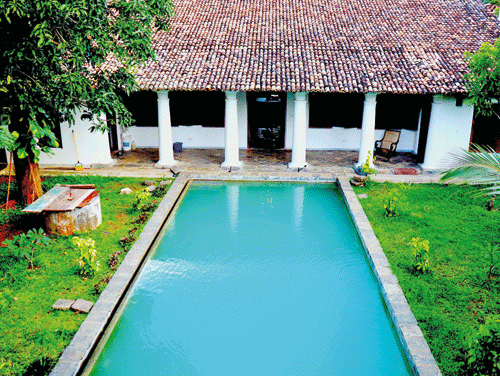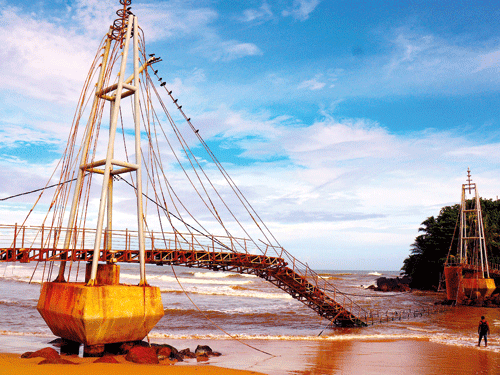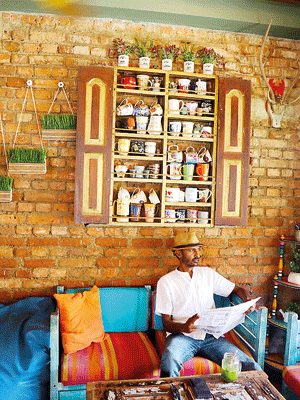Largely forgotten colonial citadel
Arch from the past
Along Sri Lanka’s trading coastline, is the garden citadel of Matara Fort, built in 1735; a place full of laughter and life, typified by the local children who play cricket and football every day on the pitch by the Dutch gate, watched over by the stoic white clock tower that stands like a tall British sentry.
As soon as you walk into the Fort, you are immediately struck by the contrast between the buzzy main street of Matara and the peaceful nature of the Fort, the one-time capital of the Ruhunu kingdom and site of one of the greatest Kandyan victories over colonialists.
I started my exploration at the Fort, reminiscent of Ankor Wat, with its Banyan trees curling around abandoned guard turrets and colonial buildings, no doubt formerly used for storing goods and accommodating tax offices for traders. On the left hand side of this historically rich and yet largely forgotten colonial citadel, is the Dutch Reform Church, built 1767; a place that feels more like a large galleon – like the ones on which Drake and Raleigh sailed the high seas – and for good reason, as there were no Geoffrey Bawa architects 300 years ago, only gifted boat builders who built many of the early structures influenced by life at sea.
The nearly 300 year-old Dutch-gabled roof is a landmark of such importance that the government offices next door, opened in 2009, have been built in the same style, in keeping with this historic city.

Restored: The elephant seller’s house
From here, one can see the courts and a warren of legal offices – still fully operational – and just some of the 50 architecturally-rich historic buildings within the Fort walls. Walking into the exceptionally arty Dutchman’s Street Café (open 10 a.m. to 10 p.m.) on Court Road for a refreshingly cool mint and lime drink, I meet Janaki, the owner and powerhouse behind this charming vintage European style street, lined with little garden eateries that leads down to the ocean.
The garden café complex is adorned with a variety of seating, from adapted Singer sewing machine tables painted in regal gold, to tables under shaded trees, that are beautifully decorated with mosaics on china.
Fuelled up for further exploration of the citadel, this time walking along Beach Road, I noticed, as I left the café, an old fashioned letter box at the entrance, and thought, ‘I will send this article by post in the hope it will become another memento for her quirky curated wall spaces.’ It’s a place full of objects and newspaper headliners, along with more serious reminders of the island’s troubled past, such as an ammunition box turned into a flower pot.

Temple bridge
As I go down side streets, a short walk on from the busy legal square where columns appear behind collapsing building frontages, that were covered by their Muslim owners, I find the exceptional 250-year-old “Gajapathigewatte”, literally, the elephant mahout’s house, which used to house the Dutch officer who organised the export of elephants through Matara Port – shown in old Dutch maps of the Fort with an enclosure where the elephants were corralled. One enterprising couple, passionate about saving Sri Lanka’s heritage, have lovingly restored the house over the last five years, hoping to inspire others.
In addition to carefully returning the original Dutch features of the house revealing walls built from coral and shell, formerly ships’ ballast – the owners cleverly decided to re-purpose the original star circles from the Muslim façade to cover the colonnaded portico in the main bedroom bathrooms, creating perfect ventilation systems and retaining its Muslim history. Using the clever design of the colonial builders, they have also positioned a Jaffna horse carving at the entrance, leading your eye through the doors and arches of the old house, along the granite-lined swimming pool, to the kitchen and dining pavilion at the very end of the garden.

Matara’s coolest cafe
Standing at the central doorway, you will understand not only the great symmetry of these historic Dutch houses, but also the clever cross ventilation system that keeps the building naturally cool all year round, even when it rains. The two pots either side of you, were once auspiciously filled with water offerings and flowers, to provide protection from sorcery and mayhem. I also learn that the flagstone flooring was discovered when they pulled up the overlying floors, with specks of black from the chequer board flagstone fashions of the time, which you can see clearly in the owners’ Dutch painting collection.
Each of the five bedrooms display Chinese, Indian, Arab, Sri Lankan and European art and artefacts reflecting the range of people who have traded in the area.
Be warned, when you reach the water’s edge, where the river meets the sea, there are crocodiles, who are more than happy to attack and feast on unsuspecting wayfarers, ignorant of their former raison d’être – to stop slaves from attempting to leave the citadel. This is an exceptional spot to take a boat and explore the nearby nature reserve. Here, Rohan the trawler-man and his crew throw red fishing nets in the air against a painted wooden fishing boat, complete with a gigantic well gnarled oar that turns out to be a twisted tree trunk. On the front of the boat, a big bundle of leaves hangs over the side to protect the fisherman from sea monsters while a painted devil mask on the bow matches the hues of the rainbow of colourful nets on the quay and equally colourful conversations.
Rohan in a past life had been an animator at a tourist hotel and is full of stories about the city and its fantastic location for fishing. You can watch the sun set from this point, take a dip in the sea, and walk back along the beach to the island’s temple, and enjoy crossing the bridge being splashed by the sea, to make a floral offering to Lord Buddha.
Walking back along Beach Road, I notice between the houses, a variety of religious buildings, including a Buddhist temple, where young monks have made Vesak lanterns, lighting not only the road, but also, I pray, the imagination of those with a love of history and an understanding that traders always picked the best spots to build.
After all, where can one be in a place surrounded by the sea, with huge colonial gardens, in walking distance of an esplanade, with buses that will take you anywhere in the country. In the vicinity, there’s a forest that still has the rarest of monkeys, the Red Loris, named by the Dutch for its clown-like features.
As all walks must end with great food and a cold beverage, my advice is to enjoy plates of spicy curry leaf cashew nuts and cuttlefish at the Fort Matara Rest House, where, in true British form, they have picked the best spot in town, so you can enjoy a fun-filled evening of Sri Lankan hospitality accompanied by the orchestra of the waves.
Searching for an ideal partner? Find your soul mate on Hitad.lk, Sri Lanka's favourite marriage proposals page. With Hitad.lk matrimonial advertisements you have access to thousands of ads from potential suitors who are looking for someone just like you.


